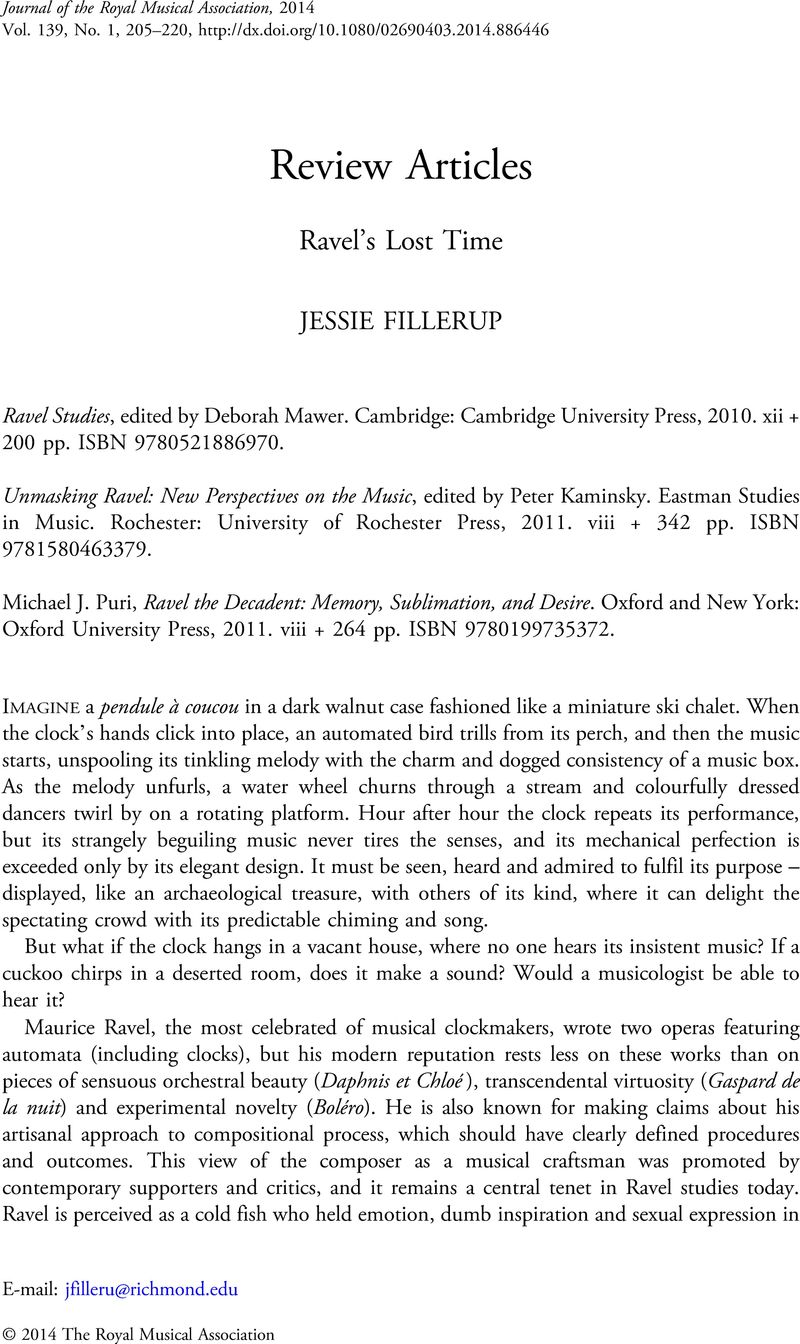Article contents
Abstract

- Type
- Review Articles
- Information
- Copyright
- Copyright © 2014 The Royal Musical Association
References
1 A Ravel Reader: Correspondence, Articles, Interviews, trans. and ed. Arbie Orenstein (Mineola, NY, 2003).
2 See Carolyn Abbate, ‘Outside Ravel's Tomb’, and Steven Baur, ‘Ravel's “Russian” Period: Octatonicism in his Early Works, 1893–1908’, Journal of the American Musicological Society, 52 (1999), 465–530 and 531–92.
3 Stephen Zank, Maurice Ravel: A Guide to Research (New York and London, 2005).
4 Edgar Allan Poe, ‘The Philosophy of Composition’, The Complete Works of Edgar Allan Poe, ed. James A. Harrison, 17 vols. (New York, 1902), xiv, 193–208 (p. 196). Here, Poe typically used the word ‘effect’ to describe an ‘impression’. Beauty is an example of aesthetic effect, since it produces a particular sensation in the reader – ‘that intense and pure elevation of soul’. When Poe mentions the ‘novel effects’ he hopes to achieve in The Raven by varying the context of the refrain, he is no longer describing the single poetic effect that governs his authorial choices. Effects (plural) may be understood as more particular phenomena: the sonorous qualities of words, for example, or their rhythmic combinations. See Jessie Fillerup, ‘Ravel and Robert-Houdin, Magicians’, 19th-Century Music, 37 (2013–14), 130–58.
5 L'enfant was premièred at the Metropolitan Opera in 1981, the Royal Opera House in 1983, the Glyndebourne Festival in 1987 and the New York City Opera in 1990.
6 Kilpatrick is probably referring to the occasional mention in Ravel biographies that the composer intended to entitle L'enfant after Colette's daughter.
7 See J. Peter Burkholder and Claude Palisca, Norton Anthology of Western Music, 5th edn (New York and London, 2005) and 6th edn (New York and London, 2009), and Mark Evan Bonds, A History of Music in Western Culture, 4th edn (Upper Saddle River, NJ, 2013). Two undergraduate anthologies that include Ravel works are Anthology for Music in Western Civilization, ed. Timothy J. Roden, Bryan Simms and Craig Wright, 2 vols. (Belmont, CA, 2005), and The Oxford Anthology of Western Music, 1st edn, 3 vols. (New York and Oxford, 2013), iii: The Twentieth Century, ed. Klára Móricz and David E. Schneider.
8 See Ulrich Mahlert, ‘Gebannte Improvisation und Maskentanz: Die “Haydn”-Stücke von Claude Debussy und Maurice Ravel’, Musik und Bildung, 19 (1987), 912–19, and Charles Rosen, ‘Where Ravel Ends and Debussy Begins’, Cahiers Debussy, 3 (1979), 31–8 (p. 32). Rosen's essay was first published in High Fidelity, 9 (May 1959), 42–4.
9 ‘Le Trio de Maurice Ravel: Analyse par l'auteur’, ed. Arbie Orenstein, Cahiers Maurice Ravel, 9 (2005–6), 59–69 (pp. 62–3). Ravel noted the thematic independence of the movements, but Heinzelmann's cyclic interpretation relies predominantly on formal and tonal relationships.
10 Bhogal's theory of rhythm and metre draws on Harald Krebs, Metrical Dissonance in the Music of Robert Schumann (Oxford, 1999), and Richard Cohn, ‘The Dramatization of Hypermetric Conflicts in the Scherzo of Beethoven's Ninth Symphony’, 19th-Century Music, 15 (1991–2), 188–206.
11 For a sophisticated analysis of Ravel's music in light of queer theory, see Michael J. Puri, ‘Dandy, Interrupted: Sublimation, Repression, and Self-Portraiture in Maurice Ravel's Daphnis et Chloé’, Journal of the American Musicological Society, 60 (2007), 317–72, esp. pp. 358–67. Benjamin Ivry's biography of Ravel (Maurice Ravel: A Life (New York, 2000)), poorly documented and idiosyncratic in approach, posits the theory that Ravel possessed a secret identity as a gay man.
12 Lloyd Whitsell, ‘Ravel's Way’, Queer Episodes in Music and Modern Identity, ed. Sophie Fuller and Lloyd Whitsell (Urbana, IL, 2008), 49–78.
13 Ibid., 61.
14 Kaminsky rightly notes that Freud's work was enjoying ‘a surge of artistic and public interest’ around the time L'enfant received its premières, but he does not historicize Freudian thought or distinguish between Freud's psychoanalytical theories and his clinical practices.
15 A Ravel Reader, trans. and ed. Orenstein, 433.
16 Oscar Wilde, ‘The Decay of Lying’, Intentions (London, 1891), 1–55 (p. 54). Carlo Caballero compares Ravel's views to Wilde's in Fauré and French Musical Aesthetics (Cambridge, 2001), 33.
17 A Ravel Reader, trans. and ed. Orenstein, 395.
18 Antoine Banès, review of La valse, Le Figaro, 13 December 1920, p. 3; Theodore Lindenlaub, review of La valse, Le temps, 20 December 1920, 2.
19 Deborah Mawer, ‘Ballet and the Apotheosis of the Dance’, The Cambridge Companion to Ravel, ed. Mawer (Cambridge, 2000), 150–5; eadem, ‘Balanchine's La valse: Meanings and Implications for Ravel Studies’, Opera Quarterly, 22 (2006), 90–116; Jessie Fillerup, ‘Purloined Poetics: The Grotesque in the Music of Maurice Ravel’ (Ph.D. dissertation, University of Kansas, 2009), 302–24; eadem, ‘Ravel, La valse, and the Purloined Plot’, College Music Symposium, 49/50 (2009–2010), 345–55.
20 William James, The Principles of Psychology, 2 vols. (New York, 1918), i, 609.
21 Ibid., 647.
22 Ibid., 609, 646.
A correction has been issued for this article:
- 1
- Cited by
Linked content
Please note a has been issued for this article.




